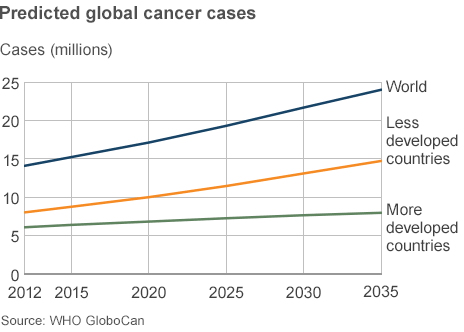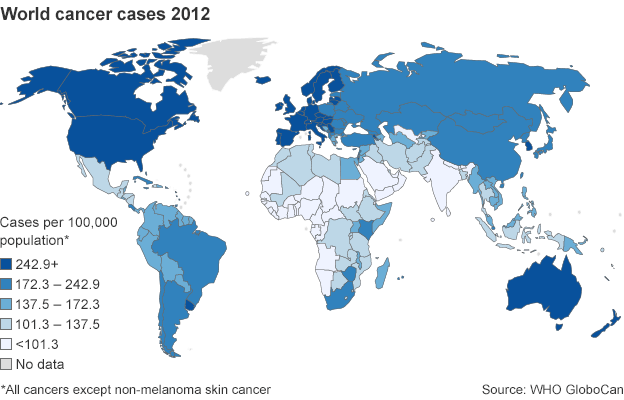The globe is facing a “tidal wave” of cancer, and restrictions on alcohol and sugar need to be considered, say World Health Organization scientists. It predicts the number of cancer cases will reach 24 million a year by 2035, but half could be prevented. The WHO said there was now a “real need” to focus on cancer prevention by tackling smoking, obesity and drinking.
The World Cancer Research Fund said there was an “alarming” level of naivety about diet’s role in cancer. Fourteen million people a year are diagnosed with cancer, but that is predicted to increase to 19 million by 2025, 22 million by 2030 and 24 million by 2035.
The developing world will bear the brunt of the extra cases.
Chris Wild, the director of the WHO’s International Agency for Research on Cancer, told the BBC: “The global cancer burden is increasing and quite markedly, due predominately to the ageing of the populations and population growth.
“If we look at the cost of treatment of cancers, it is spiraling out of control, even for the high-income countries. Prevention is absolutely critical and it’s been somewhat neglected.”
The WHO’s World Cancer Report 2014 said the major sources of preventable cancer included:
- Smoking
- Infections
- Alcohol
- Obesity and inactivity
- Radiation, both from the sun and medical scans
- Air pollution and other environmental factors
- Delayed parenthood, having fewer children and not breastfeeding
For most countries, breast cancer is the most common cancer in women. However, cervical cancer dominates in large parts of Africa.
The human papillomavirus (HPV) is a major cause. It is thought wider use of the HPV and other vaccines could prevent hundreds of thousands of cancers. One of the report’s editors, Dr Bernard Stewart from the University of New South Wales in Australia, said prevention had a “crucial role in combating the tidal wave of cancer which we see coming across the world”.
Dr Stewart said human behavior was behind many cancers such as the sunbathe “until you’re cooked evenly on both sides” approach in his native Australia. He said it was not the role of the International Agency for Research on Cancer to dictate what should be done.
He said there was a similar argument to be had with sugar fueling obesity, which in turn affected cancer risk.
Source: BBC








